|
|
|
 |
Commentary, feedback or questions invited |
Cairo
Cairo, on first
visit, is both awesome and disappointing. The city is overcrowded,
noisy and in many places squalid. The air is so polluted by automobile
fumes and soot that from the elevation of the Citadel you can see it as
a layer of orange haze. To accommodate the exploding population, the
city has built countless new constructions all along the way between
central Cairo and Giza. Unfortunately, many of these are somewhat
shabby four and five storey houses of brick and cement which hint of
the slums they will become within twenty years. Such construction has
spread inexorably outward until it is at the very foot of the pyramids.
But the awesome part is that one knows, one senses every minute, that
this is an ancient land, heavy with history and filled with things
beyond our understanding. Signs are in a language an American cannot
decipher, men are in galabiyas, long shirt-robes that are scarcely
different from biblical times, and many of the women wear the hijab,
the full scarf that covers all their hair. Having traveled all over
western Europe, I can patch together friendly little phrases in all the
main European languages, but it is a very different thing to try to
take of business in Arabic.
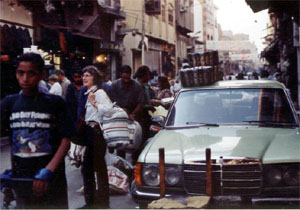
Justine in the crowded streets of Old
Cairo
|
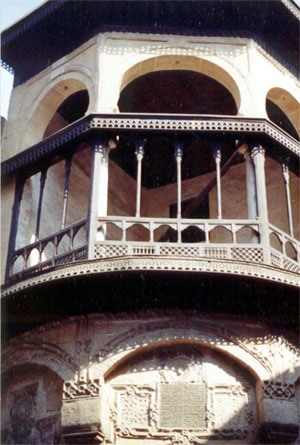
Splendid example of Old Cairo's islamic
architecture
|
The Egyptian Museum
| Angelique took me first to
the Cairo museum which contains not only the entire Tutankamun exhibit
(much more than had made the tour of Europe and the US in the 1970s)
but also the Royal Mummies. In a special room, small and unworthy of
the dignity of their age, the mummies of several pharaohs and queens
were displayed unwrapped under glass. Most impressive by far was Ramses
II (Ramses the Great). His dark and desiccated hawk face was fully
intact after 3,000 years, and did not look much worse than it probably
looked in life, considering that the man died close to the age of 90
(after a reign of 66 years.) The Tutankhamun exhibit was much flashier
and more of an attraction to tourists, and one had to press into the
middle of the dense crowd before the famous sarcophagus, mask, shrine,
and chariot of the murdered king. The pieces were stunning in their
opulence, of course, but it was also a relief to be able to break away
and simply meander among the other rooms looking at the more anonymous
stelae, chests, statues and canopic jars. |
| The last artifact we looked
at was the famous granite stela of Meremptah which – dated about 1200
BC – contains the only reference to Israel in Egyptian writing.
Contrary to the myth of a Jewish slave population building the
pyramids, this stela is viewed as a strong indication that Jews did not
even come to the notice of the Egyptians until the New Kingdom, over a
thousand years later. |
Khan el Khalili
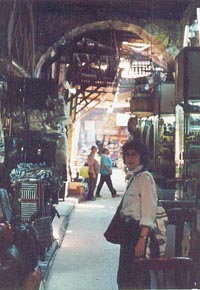
|
Khan al Khalili
in the al Azhar district, is Cairo’s souq, and its narrow alleys and
shops give a sense of what Cairo – and probably most other Arab cities
– were like a millennium ago. Angelique knew it like her hand and she
led me through its medieval streets with aplomb. Urchins begged
baksheesh from us on many of the streets, and the sullen way they
accepted our money suggested they had to hand it over to a parent or
employer. One could not make them smile.
But every merchant was our
immediate friend. Every one promised us the very best merchandise at
the best price, and offered us tea, a cushion, a history of the Khan,
anything to begin a business relationship. They seemed to be able to do
this in Arabic, English, French or German. Cleverly, we went first to
the cotton souq to buy a bag to carry everything else in. Then it was
to the spice market to buy karkady (hibiscus tea), cardamom, saffron;
to the weavers for a camel bag, and to the brass souq for a brass
kettle. In the heat of the day, Angelique brought me to that
quintessentially Arab institution, the coffee house. El Fishawy, the
place of mirrors, was an alley lined on both sides with benches and
tiny tables where one could order hot or cold drinks and sheesha, that
is, a tall hookah with apple-flavored tobacco to smoke. It was a
perfect place to watch the passersby they way the Egyptians had watched
us, in a pleasant lethargy.
|
Camels, Desert and Pyramids
The desert
between Cairo and Saqqara is not very nice. We rented camels for a trek
through the desert to the step pyramid at Saqqara and I, at least,
expected Lawrence-of-Arabia dunes. We found instead that the edge of
the desert near the city is largely a dump where trash is left out to
desiccate and blow away. So we soon found ourselves passing through
automobile tires, construction refuse, miscellaneous metal objects, and
a dead horse picked at by birds. Riding a camel was amusing, although a
bit more fatiguing than riding a horse, since you sway in a sort of
circular motion, on muscles you are not used to using. The camels were
in poor condition, and their saddles ragged, and we feared that the
money we spent renting them did nothing to improve their care. The two
hour ride between Giza and Saqqara was not particularly demanding, and
at the Saqqara step-pyramid complex Angelique the Egyptologist gave me
a rundown of its history. Much nicer than a guidebook
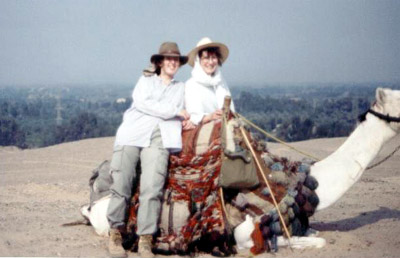
Camera-shy camel...
|
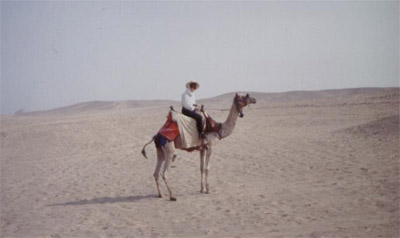
Justine riding off
into...nothing
|
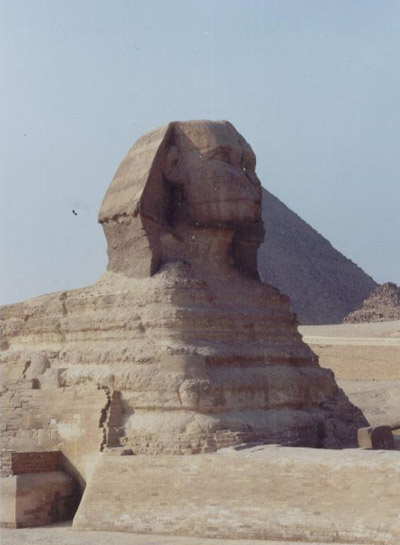
Khepren looking forever on
towards sunrise
|
The Great
Pyramids are the stupendous tombs of Khufu (Greek: Cheops) Khafre and
Menkaure on the Giza plateau. They are surrounded by dozens of smaller
pyramids, mastabas and a necropolis and constitute with them an
enormous park of the ancient dead. What the postcards and the history
book photos do not reveal however, is that the squalid little town of
Giza has now oozed out like lava and spread almost to the foot of the
Sphinx. The pyramids themselves are still awesome by their very size
and antiquity, but it is difficult to feel the mystery with so many
tourists and merchants all about. We rode first on horseback out into
the unpolluted part of the desert on the western side, and simply sat
awhile, absorbing the experience of being before the most ancient of
edifices. Then we viewed the splendid solar barque which had recently
been unearthed – and reconstructed – at the site.
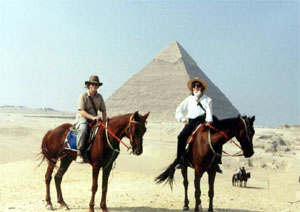 |
|
Justine
and Angelique riding at Giza
|
|
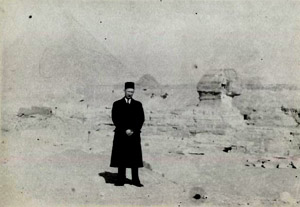 |
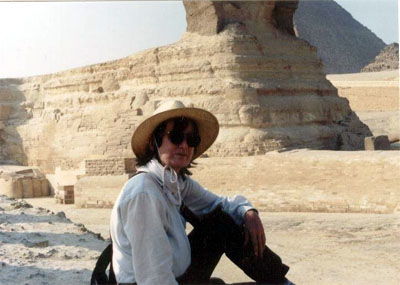 |
|
Like
Father, like daughter
|
|
Winter
1928
|
Spring
2000
|
|
|
|
|
Dr.
Salam Baker, Angelique and Justine at the closing dinner of the 8th
International conference of Egyptologists
|
Closing
Dinner of the 8th International conference of Egyptologists, at the
foot of the pyramids
|
Overnight Train to Luxor
| The overnight
train to Luxor is boarded at Ramses Station, in downtown Cairo. We
reserved a first-class cabin for the night, and after a tolerable
supper, we turned off the light and starred out the window at the
villages the train passed during the night. We passed through towns of
all sizes, some lit with modern lighting and some, the smaller
villages, with only the scantiest of electric service. But everywhere
there were minarets, large and small, lit up with neon lighting, almost
always green. Near the tracks we caught sight of men in groups
squatting on the ground in their galabiyas in the semi-darkness. We
presumed they waited for a train, not ours, but in the dim light, they
looked like souls in purgatory. |
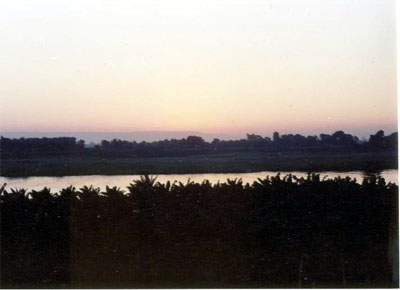
View of the Nile as our train slowly
leaves the Cairo area
|
|
|
|